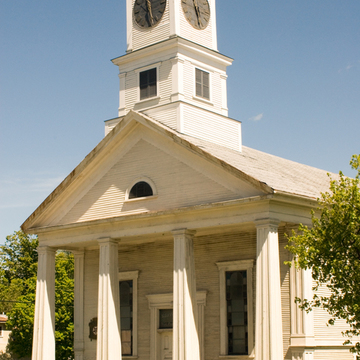You are here
Masonic Temple (Baptist Church)
This former Baptist meetinghouse illustrates how the adaptation of Greek Revival forms to local or a builder's limitations led to distinctive aesthetic results. Its form is typical for the mid-nineteenth century: a clapboarded temple-fronted block with an entrance vestibule that gives onto a ground-floor vestry and an elevated sanctuary. Set back above the portico is a square multistage tower that rises from a low, originally flush-boarded base past a squat belfry to a taller clock stage, originally crowned with a volute-scrolled parapet. The decorative vocabulary is conventional—window and door frames with ears and broad plain entablatures on corner pilasters. However, the portico's columns are unconventional. Rather than turned cylinders, they are square piers with narrow panels on each face that taper from the base to a simply molded cap that imparts an Egyptian quality. The paneled form of the columns is repeated in the frame of the door and the articulated pilasters of the front corners of the main block. This solution, repeated in 1866 (possibly by the same builder) for a Baptist church in Montgomery, is testimony to the vigor and flexibility of Greek Revival as a style for vernacular invention. In 1919 the building was acquired by the Masonic Order, but the tower and its clock remain town property.
Writing Credits
If SAH Archipedia has been useful to you, please consider supporting it.
SAH Archipedia tells the story of the United States through its buildings, landscapes, and cities. This freely available resource empowers the public with authoritative knowledge that deepens their understanding and appreciation of the built environment. But the Society of Architectural Historians, which created SAH Archipedia with University of Virginia Press, needs your support to maintain the high-caliber research, writing, photography, cartography, editing, design, and programming that make SAH Archipedia a trusted online resource available to all who value the history of place, heritage tourism, and learning.









